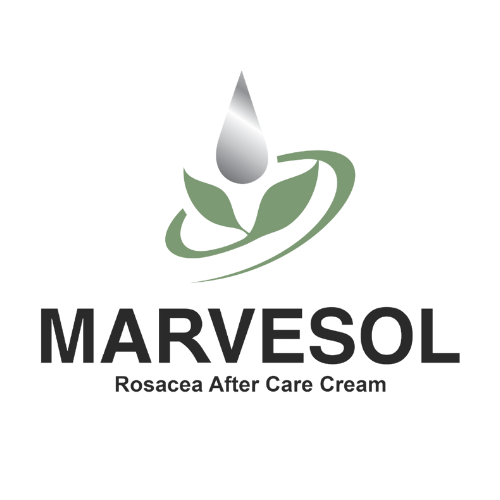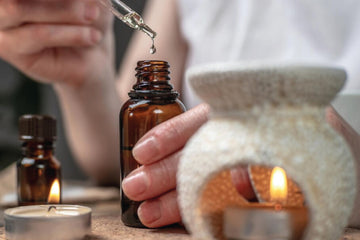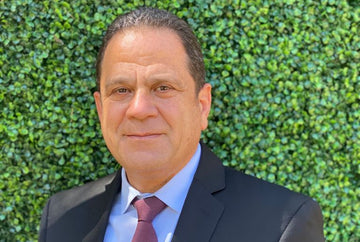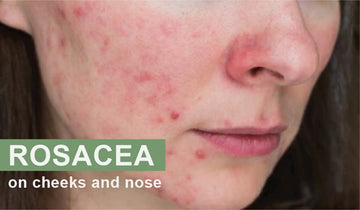6 Essential Oils to Treat Rosacea and Soothe Flare-Ups Naturally
The 6 essential oils that can stop rosacea from ruining your skin and can act as a natural treatment for flare-ups on your nose, forehead, cheeks and face.

If you’ve been struggling with rosacea on your nose, rosacea on your forehead or rosacea on your cheeks you know exactly how painful and humiliating a flare-up can be. You’ve probably found yourself wondering how you can treat rosacea, how you can avoid rosacea triggers and calm rosacea flare-ups. Rosacea may not have a cure, but the good news is there are solutions and treatments for rosacea and the key is essential oils.
What is rosacea?
Rosacea is a chronic skin condition, and as those who suffer with rosacea symptoms can tell you, it’s painful and embarrassing. Rosacea causes redness, swelling and visible blood vessels on the face, particularly the cheeks, nose and forehead. The symptoms of rosacea come and go in what’s called flare-ups.
The most common physical symptoms of rosacea include:

- Red face: Those suffering from rosacea often have redness on the face, usually on the cheeks, chin, nose and forehead. The redness will come and go, but it can be worse after eating spicy foods, being out in the sun for an extended period of time, drinking hot beverages, drinking alcohol and physical exertion.
- Pimples and bumps: Small red bumps, called papules appear on the face during a rosacea flare-up. Pus-filled pimples, called pustules, can also appear on the face, but are especially common on the nose. These bumps and pimples can be painful, tender and sometimes look like acne.
- Eye problems: Dry eyes, itching, burning and redness in the eyes can be a symptom of rosacea. If left untreated it could also cause vision problems.
- Flushing: For those suffering from rosacea, one symptom could be flushing of the face, or blushing, usually in response to emotional stress or even exposure to the sun.
Rosacea isn’t always painful, but some people do experience some discomfort and pain. Sometimes during a rosacea flare-up people experience burning or stinging on their face. The most painful part of rosacea flare-ups might not be the physical symptoms, but the emotional ones. Many people with rosacea feel self-conscious about how they look, especially when they have redness or bumps on the face.
Common emotional symptoms of rosacea include:

- Feelings of low self-esteem and anxiety: People with rosacea might experience depression or anxiety because of the impact of rosacea on their social life and self-esteem.
- Social isolation: People suffering from a rosacea flare-up might avoid social situations or activities because of the painful symptoms, fear of exposure to sunlight or certain foods, or embarrassment of the way their skin appears. This leads to social isolation and loneliness.
- Issues at work: Stress and anxiety are common at work for someone who is afraid of facing harassment or discrimination because of their appearance during a rosacea flare-up.
What causes rosacea?
The exact cause of rosacea is still a mystery, although it is believed to be a combination of both genetics and the environment. Rosacea is not contagious and rosacea is not caused by poor hygiene. Rosacea is common and it affects people of all ages. Most people diagnosed are over the age of 30 with fair skin. Women are more likely to be diagnosed with rosacea than men. Rosacea can affect people of all ethnicities, but those with fair skin are more likely to experience symptoms.
Because rosacea is underdiagnosed, and many people with mild symptoms don’t talk to their doctor about it, the exact number of people with rosacea is hard to determine. According to the National Rosacea Society, there are approximately 16 million people in the United States that have rosacea.
Rosacea is a chronic condition and there is no cure, but it can be managed. Lifestyle changes, like avoiding spicy foods, hot beverages and sun exposure can reduce rosacea flare-ups. Also, essential oils can provide relief from symptoms and be an effective treatment.
Here are some factors that are believed to contribute to the development of rosacea:
- Genetics: Rosacea does tend to run in families, if someone in your family suffers from rosacea symptoms you will want to watch for symptoms in your own skin.
- Abnormal blood vessels: abnormalities in the blood vessels in the face can lead to redness and flushing in the face.
- Immune system dysfunction: an abnormal immune system response can lead to swelling and irritation in the skin.
- Demodex mites: Tiny insects that live in hair follicles on the face, called Demodex mites, are present on most people’s skin. Those who suffer from rosacea have more mites on their face than those who don’t, which might contribute to developing rosacea.
- Environmental triggers: things like spicy foods, hot beverages, alcohol, stress and sun exposure can cause rosacea flare-ups in some people.
How to treat rosacea?
Essential oils have been rising in popularity in the United States- and with good reason! Many people are looking for better, safer alternatives to other products on the market that contain harsh chemicals. When it comes to taking care of your skin and soothing rosacea flare-ups, essential oils are key. Essential oils are natural and organic. They are versatile, free of harsh chemicals and are widely available and convenient to purchase.
Essential oils have natural healing properties that can alleviate a variety of health conditions, including rosacea.
There are 6 essential oils that can help you take back control over your rosacea symptoms.

- Lavender: Lavender oil is one of the most powerful in fighting rosacea symptoms on the skin. Lavender promotes wound healing, activates skin renewal and gives you smooth, calm and even skin.
- Ginger Grass: Another important essential oil in your fight against rosacea is ginger grass. Ginger grass improves circulation and increases blood flow, both necessary in rosacea management, and leaves your skin smooth and uplifted.
- Lemongrass: Lemongrass has antibacterial and astringent properties that will cleanse the skin, remove oil and shrink pores. Lemongrass is your sidekick for rosacea flare-ups.
- Verbena Oil: Verbena is an essential oil that has antibacterial and anti-parasitic qualities that helps keep your skin parasite-free. Verbena is important to rosacea treatment because it reduces painful inflammation.
- Peppermint Oil: Peppermint oil takes on rosacea with its ability to stimulate the skin. It widens the capillaries and blood vessels, promoting healing.
- Jojoba Oil: Jojoba oil is full of antioxidants that protect the skin from damage that can happen during rosacea flare-ups.
Essential oils are a powerful, natural way to reduce the flare-ups and pain associated with rosacea. With the right blend of oils, you can soothe your skin and reduce inflammation. The oils also provide anti-bacterial, anti-inflammatory, and anti-aging benefits that can help to improve the overall appearance of your skin.
In addition to helping you find relief from painful flare-ups, essential oils can also be used as part of an all-natural approach to long-term healing. Essential oils contain powerful antioxidants that help protect against free radicals and promote a healthy balance of bacteria on the skin--both of which are important when it comes to preventing future outbreaks.
3 simple tips to help you manage rosacea symptoms.
Everybody is different and symptoms show up differently for everyone, so try things with curiosity and journal to see how your skin feels after.
- Avoid spicy foods. It’s hard to think about saying goodbye to your favorite foods, but what if it could help clear-up the rosacea symptoms you’re experiencing on your nose, chin, cheeks and forehead? Go for something mild and your skin will thank you.
- Drink cold Beverages. Make the switch, it’s so simple and it really helps your skin stay calm. If you love warm coffee, tea or cocoa try switching it for cold beverages. Carry ice water with you, order lemonade, juice or even a smoothie instead.
- Use the right products. You need to be on the look-out for products that are non-irritating and designed specifically for sensitive skin. There are lots of personal care products on the shelf that use harsh chemicals like parabens, sulfates and phthalates that prolong the shelf life of the product and make it smell good. Avoid them! Look for products that use essential oils and all natural ingredients. Your skin will thank you!
If you’re ready to take advantage of essential oils’ healing properties and find some relief from your rosacea symptoms, the answer is in Marvesol’s Rosacea After Care Cream.
How Marvesol combines essential oils with botanicals for rosacea after care
Marvesol is incredible at soothing your skin while using the most gentle ingredients possible: botanicals and essential oils! The formula for Marvesol comes directly from ancient remedies passed down for generations in the Mediterranean. Marvesol contains ALL SIX of the essential oils that help beautify the appearance of rosacea with zero harsh chemicals.
Click HERE to see the Marvesol Rosacea After Care Cream label (hint: all 6 of the best essential oils to treat rosacea on the face are there!)
Click here to order your first bottle of Marvesol Rosacea After Care Cream with 6 essential oils.
How to Use Marvesol Rosacea After Care Cream

- Clean your face
- Pat your face dry with a towel
- Squirt a small amount on your finger and apply to trouble areas on your face
- Gently rub in and massage until it’s absorbed
- Apply twice per day, leave on overnight if possible
- Use morning and night for 15 days and be wowed by results!
You might feel a warm, tingling feeling on your face as the cream penetrates the skin. Also, Marvesol chooses not to use harmful fragrances in their products to avoid allergic reactions, so don’t be concerned if it doesn’t smell like flowers.
Click here to see before-and-after rosacea pictures.
Click here to order your first bottle of Marvesol Rosacea After Care Cream.
By taking advantage of this natural treatment option, you can enjoy healthier looking skin with fewer rosacea symptoms without having to resort to harsh medications or procedures. Marvesol is designed specifically for your needs--allowing you to take back control over your rosacea symptoms!
FAQ’s:
How can I get rid of rosacea on my cheeks and nose?
- Avoid spicy foods
- Drink cold beverages instead of hot
- Use the right products. Avoid harsh chemicals and use only natural products on your skin
Which essential oils help treat rosacea?
Lavender, Ginger Grass, Peppermint, Lemon Grass, Verbena, and Jojoba oil.
What are the symptoms of rosacea?
Physical: Pimple-like bumps, pus-filled bumps, stinging or burning skin, rough and dry sensitive skin, swollen or red eyes.
Emotional: Low self-esteem, lack of confidence, social isolation, depression, anxiety





